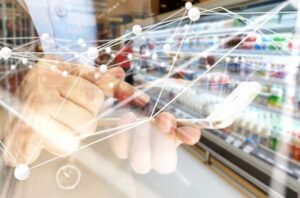Digital transformation sure did a number on impulse shopping. Even before COVID-19 drove customers online en masse, the impulse-friendly 18-34 age group was already making fewer trips to the physical store, and for fewer items. Now, more customers buy online and in-store clientele are spending less time roaming the aisles. The result is more “mission-driven” shoppers who are less likely to make unplanned purchases.
Online shopping is not the only technology that is putting pressure on impulse. For those buyers who do make it into stores, the growing penetration of self-checkout, smart carts, and smartphone scan-and-pay technology means less time waiting in line (and therefore less temptation to buy fizzy drinks, sugary and salty snacks, gum, and tabloid news magazines).As a result, the impulse category has been flat for years, with some segments like snacks and magazine sales experiencing double digit annual declines. It’s time for a re-think of impulse both on and offline. Here are a few ways of approaching this:
1. In-store, cater to customer needs more than desires
Go to just about any grocery store in America and you’ll see the same kinds of items at check-out—those driven by visceral desire, rather than genuine need. It makes sense, really. Impulse purchases are unplanned because they are unneeded. Less time in line means less opportunity to cave in to desires, and that is hurting in-store impulse sales.
What would happen if grocers took some of the real estate allotted to “nice to haves” like candy and magazines, and reassigned it to things that customers really need, but may have forgotten to buy?
It’s an unconventional way to think about “impulse,” but when you think about it, it’s quite easy to say no to that bag of M&Ms when you are quickly breezing through a self checkout line. But wet wipes, hand sanitizer, and toothpaste are household “must haves” these days. Perhaps fast-moving, mission-driven shoppers will be more likely to top up their carts when they are offered reminders of things they really should buy anyway.
2. Make impulse purchases all about personalized “food discovery”
Most people will tell you that the sensory experience and irresistible temptation of impulse purchases is impossible to replicate online. That’s fine—you shouldn’t be offering those kinds of impulse items online anyway. Nobody thinks that websites should be perfect digital reproductions of brick-and-mortar stores.A concept which works much better online is what we at Halla like to call “personalized food discovery.” Here’s an example: Imagine that a shopper has already placed ground beef and bell peppers in his or her online shopping cart. Those could be part of a recipe or perhaps perfectly unrelated purchases. Either way, you can help your shopper imagine delicious uses for those ingredients and you can suggest complementary items that perhaps they never considered. Propose exotic spices and a box of couscous to make Moroccan stuffed peppers, or suggest taco shells and guacamole to create a Mexican fiesta at home.This does not need to be limited to recipe suggestions though. You can also suggest items that match your shopper’s lifestyle preferences or current state of mind. Say they have fair trade coffee and free-range eggs in their cart, for instance. Ok, so you can offer products with a social mission, like Ben & Jerry’s ice cream or KIND bars. If they added chicken breasts and whey protein powder, you can suggest beef jerky sticks and protein bars.This may seem like a very unconventional way to think about “impulse” purchasing. But the kinds of unplanned purchase items that work in-store are selected for their universal appeal—prime store real-estate is too valuable to cater to individual preferences. Online, you don’t have that problem. Personalized recommendations eliminate the need to cater to the lowest common denominator in the same way that Netflix and Spotify killed “one size fits all” radio and television. Personalization also increases basket size by as much as 40% and improves shopping experience. This works just as well with in-store smart carts and shopping apps.
3. Remember that customers are now “always online”
It used to be that the checkout aisle is where most unplanned purchasing happened. Where is the home of impulse today? It’s in every shopper’s pocket. If you have a shopping app, you don’t have to wait for customers to come to you. Impulse buys are driven as much by sheer boredom as by any other factor.
Even if they are not waiting in line at your store, shoppers still have to wait in line at the post office, on the subway platform, and at the department of motor vehicles. It’s a great time to take care of the grocery shopping— and add in a few tempting treats.
You can also think about your customers’ “virtual pantry” across digital shopping channels. Online purchase data can inform your impulse ideas for in-store shopping apps and smart carts, and vice-versa. Allow shoppers to set up standing orders for the products they need delivered regularly, and keep track of when they last purchased them in any channel. This allows you to help manage the shopping process even when customers are not thinking about it. When the time comes for a restock, present creative, personal offers for items that complement those in their regular cooking arsenal. And if a shopper has made any unplanned purchase recently, you can even suggest adding them to the faithful reorder list.On the surface it may look like the lucrative impulse purchasing category is doomed. In reality, the digital channels that have disrupted impulse purchasing also hold the power to rejuvenate it.Ultimately, each shopper should have a personalized, omni-channel “store” of their own, with offers tailored to their unique purchase history and taste preferences. Grocery shopping is changing both in-store and online. This presents savvy grocers with a great opportunity to observe shoppers’ new habits and redefine the model of impulse buying.

